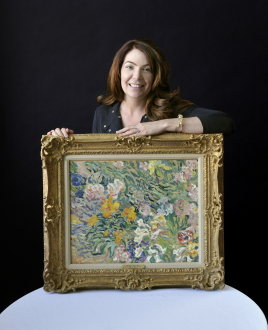Artist. Teacher. Community activist. Tailor. Seaman. Social observer. Mentor. Taxi driver. Gambler.
Artist Norman Lewis was not just one, or a few, of the above; he was all of them. Many of those roles were simultaneous. The rich complexity of his life was an integral part of his paintings, drawings and three-dimensional pieces.
That diversity makes Lewis a fascinating man and an intriguing artist. It also contributed to his relative obscurity until recently. He was restlessly inventive and experimental. As an artist, he never developed a signature style or stuck to a single overarching theme.
Lewis worked in mixed media before that became a fashionable catchphrase in the art world. Many of his works combine pastel, oil, watercolor and crayon. He explored every possible medium and form in pursuit of a “new visual order” that would integrate both sociopolitical and purely formal and artistic ideas. In addition to paintings, drawings and lithographs, his output included sculptures, needlework and three-dimensional soft figures.
Most of all, Lewis’s work was largely overlooked because he was a Black man living and working in his native Harlem in the mid-20th century. Doors — especially gallery and museum doors — that were open to his white contemporaries and friends such as Ad Reinhardt, Mark Rothko and Mark Tobey were rarely opened for Lewis.
Born in 1909 to hard-working parents from the Caribbean, Lewis was from his childhood intensely sensitive to and interested in the visual world. But his family could not provide the luxury of specialized fine art training. His art education came from books and closely studied museum shows, particularly of the Mexican muralists, Postimpressionists such as Vincent van Gogh and Henri Matisse and abstract painters like Arshile Gorky, all of whose works were being widely exhibited in the 1930s.
Lewis’ only formal art study was with the pioneering Black portrait sculptor Augusta Savage, who had her studio in the basement of the building where Lewis worked in a garment business. Savage inspired and mentored the ambitious young man with her teaching and her example as an activist for Black art at the Harlem Artists Guild and the Harlem Community Arts Center.
The 1920s and 1930s were formative years for Lewis. The ferment of the Harlem Renaissance, a sociocultural flowering in Manhattan’s premier Black community that spanned the Roaring ’20s; the deprivations of the Great Depression; and ominous political developments in Europe and Asia provided the themes for Lewis’ early work.
Social Realism was at first the dominant pattern in the complex tapestry of his art. Homelessness, police brutality, evictions, bebop music were all part of the Harlem scene he was immersed in, and all of these were prominent in his fast-growing artistic output in these years.
Along with his painting in the 1930s, Lewis studied at Columbia University and worked as an art teacher in President Franklin D. Roosevelt’s Works Progress Administration. He continued to engage with social issues as both activist and artist but increasingly moved away from representational work towards his own version of Abstract Expressionism. He was the first African-American to be associated with the movement.
Lewis’ exploration of abstraction deepened after World War II. This was prompted largely by his disillusionment with American society, which fought a racist ideology abroad during the war while maintaining segregation in its own armed forces. (The military would not be desegregated until 1948.)
He concluded that despite the vigorous activism in which he played a leading role, the art world didn’t have (or perhaps wouldn’t exert) the power to influence politics in a more progressive, egalitarian direction. Thus Abstract Expressionism, not Social Realism, became his preferred path to developing his aesthetic interests and wide-ranging artistic skills.
Yet his later works displayed a distinctive fusion of abstraction and figurative art. Music had always intrigued and inspired him, evident now in rhythmic lines and suggested figural shapes that wove through layers of subtle color.
Late in his career, Lewis received fellowships from the National Endowment for the Arts and the Guggenheim Foundation. These honors were belated recognition of his success in achieving an objective that he once expressed to an art historian thusly: “The goal of the artist must be aesthetic development and in a universal sense, to make in his own way some contribution to culture.”
Lewis was an outlier and an innovator. The renewed interest in his complex and fascinating body of work is recognition, however belated, of his considerable contributions to American and world art and culture.
For more, contact Katie at kwhittle@skinnerinc.com or 212-787-1114.



